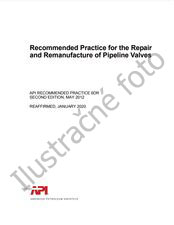Potrebujeme váš súhlas na využitie jednotlivých dát, aby sa vám okrem iného mohli ukazovať informácie týkajúce sa vašich záujmov. Súhlas udelíte kliknutím na tlačidlo „OK“.

API TR 684-1-ed.1
API Standard Paragraphs Rotordynamic Tutorial: Lateral Critical Speeds, Unbalance Response, Stability, Train Torsionals, and Rotor Balancing
NORMA vydaná dňa 1.11.2019
Informácie o norme:
Označenie normy: API TR 684-1-ed.1
Dátum vydania normy: 1.11.2019
Kód tovaru: NS-1140742
Počet strán: 538
Približná hmotnosť: 1645 g (3.63 libier)
Krajina: Americká technická norma
Kategória: Technické normy API
Anotácia textu normy API TR 684-1-ed.1 :
API TR 684-1, 1st Edition, November 2019 - API Standard Paragraphs Rotordynamic Tutorial: Lateral Critical Speeds, Unbalance Response, Stability, Train Torsionals, and Rotor Balancing
Introduction
This document is intended to describe, discuss, and clarify the API Standard Paragraphs (SP) Section 6.8 which outlines the complete lateral and torsional rotordynamics and rotor balancing acceptance program designed by API to ensure equipment mechanical reliability. Background material on the fundamentals of these subjects (including terminology) along with rotor modeling utilized in this analysis is presented for those unfamiliar with the subject.
The standard paragraphs are introduced with references to the appropriate background material to enhance the understanding. This information is intended to be a primary source of information for this complex subject and is offered as an introduction to the major aspects of rotating equipment vibrations that are addressed during a typical lateral dynamics analysis. It is not intended to be a comprehensive guideline on the execution of rotordynamics analyses but is intended to:
- a) provide guidance on the requirements for analysis;
- b) aid in the interpretation of rotordynamics reports;
- c) provide guidance in judging the acceptability of results presented.
Organization
The document is divided into six sections:
- 1. Overview
- 2. Lateral Dynamic Analysis
- 3. Stability Analysis
- 4. Torsional Analysis
- 5. Balancing of Machinery
- 6. Standard Paragraphs
The individual sections have been prepared in a stand alone manner. As a result, necessary material may be repeated in a succeeding section to provide sufficient clarity to the discussion.
Sections two through four have a parallel organization:
- — Modeling criteria
- — Analysis techniques and results
- — Machine specific considerations
- — Testing
- — Applications and examples
Standard Paragraphs
In order to aid turbomachinery purchasers, the American Petroleum Institute’s Subcommittee on Mechanical Equipment has produced a series of specifications that define mechanical acceptance criteria for new rotating equipment. Experience accumulated by turbomachinery purchasers over the past ten years indicates that if the API standards are properly applied, the user can be reasonably assured that the installed unit is fundamentally reliable and will, barring problems with the installation and operator misuse, provide acceptable service over its design life.
An integral component of these individual equipment specifications is contained in the API Standard Paragraphs, those specifications that are generally applicable to all types of rotating equipment. The criteria associated with lateral and torsional rotordynamics and balancing have been categorized as standard paragraphs. In rotating equipment specifications published by API (for example, API Standard 617—Axial and Centrifugal Compressors and Expandercompressors for Petroleum, Chemical and Gas Industry Services) there is a section on rotordynamics and balancing. The backbone of those sections is the standard paragraphs augmented by additional information that is applicable only to the type of unit considered in the standard.
The Dynamics Standard Paragraphs originated in the Centrifugal Compressor Standard, API 617. A timeline for the first through eighth editions with major highlights is [1]:
- — 1st Edition June 1958—dynamics section added. A critical speed separation margin defined and a balance/ vibration criterion established. Vibration limit in operating speed range for mechanical test is a step function.
- — 2nd Edition April 1963—torsional analysis added as an option.
- — 3rd Edition October 1973—balance criteria and separation margin for laterals below operating speed range adjusted, rotor response required when specified, torsional analysis required on motor driven and geared units, vibration limit in operating speed range changes from step function to (12,000/MCOS)0.5 or 2.0 mils whichever is less and vibration limit added at trip speed.
- — 4th Edition November 1979—AF (amplification factor) limited when passing through lateral critical speeds, lateral analysis required including a rotor response and transient torsional analysis for all synchronous motor-driven units.
- — 5th Edition April 1988—removed limits on AF while passing through lateral critical speeds, acceptance defined basis rotor response analysis, lateral analysis report requirements spelled out in detail, operating seal clearance criteria added, separation margin for laterals tied to amplification factor, amplification factor less than 2.5 acceptable in any operating case, a dynamics shop test included, and balance criteria modified.
- — 6th Edition February 1995—lateral paragraphs reorganized and criteria set for comparison with shop test evaluation and transient torsional required with variable speed motors, and vibration limit in operating speed range changes to (12,000/maximum continuous speed)0.5 or 1.0 mils whichever is less (had been 2.0 mils).
- — 7th Edition July 2002—formula for allowable separation margins for lateral criticals changes, unbalance response test criteria clarified, stability analysis requirement included, and entire section updated.
- — Proposed 8th Edition—active magnetic bearing specificati
Odporúčame:
Aktualizácia technických noriem
Chcete mať istotu, že používate len platné technické normy?
Ponúkame Vám riešenie, ktoré Vám zaistí mesačný prehľad o aktuálnosti noriem, ktoré používate.
Chcete vedieť viac informácií ? Pozrite sa na túto stránku.



 Cookies
Cookies
